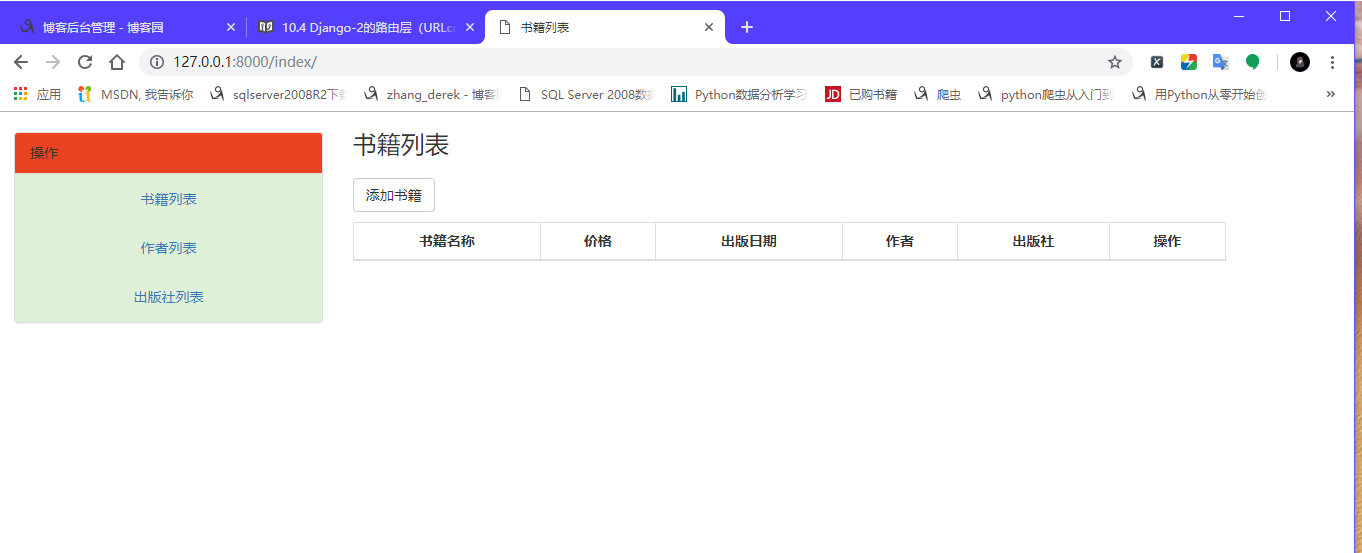003---设计首页index页面
2018-11-09 11:36
141 查看
在项目的urls.py文件添加一条url
from django.contrib import admin
from django.urls import path, re_path
from app01 import views
urlpatterns = [
path('admin/', admin.site.urls),
re_path('^$', views.index), # 加入这条,代表什么都不匹配。打开127.0.0.1:8000就不会匹配不到任何url,依然走index视图。
path('index/', views.index, name='index'), # 首页的url,走index视图,添加index反向解析,也可以不加。
]
在首页我们应该显示书籍列表。
所以在index视图函数应该获取所有数据,传递给index.html模版渲染。
def index(request):
# 获取所有书籍
book_lt = Book.objects.all()
# 渲染到index.html页面
return render(request, 'index.html',{"book_list":book_lt})
对三个模型做增删改查后,为了方便我们交互,所以把模版分为左右两板块,这样操作其他页面时,左边内容不变。
添加base.html文件作为母板。方便继承。(所有的html模版存放到项目目录的templates文件夹下)
<!DOCTYPE html>
<html lang="zh_CN">
<head>
<meta charset="UTF-8">
<meta http-equiv="x-ua-compatible" content="IE=edge">
<meta name="viewport" content="width=device-width, initial-scale=1">
<!--标题块-->
{% block title %}
{% endblock %}
<link rel="stylesheet" href="/static/bootstrap-3.3.7/css/bootstrap.min.css">
<link rel="stylesheet" href="/static/book.css">
</head>
<body>
<div class="container-fluid">
<div class="row">
<div class="col-md-3">
<div class="panel panel-default action">
<div class="panel-heading">操作</div>
<ul class="list-group">
<li class="list-group-item aaa"><a href="{% url 'index' %}">书籍列表</a></li>
<li class="list-group-item aaa"><a href="#">作者列表</a></li>
<li class="list-group-item aaa"><a href="#">出版社列表</a></li>
</ul>
</div>
</div>
<div class="col-md-8">
<!--主体内容块-->
{% block body %}
{% endblock %}
</div>
</div>
</div>
<script src="/static/jquery.js"></script>
<script src="/static/bootstrap-3.3.7/js/bootstrap.js"></script>
</body>
</html>
左边有个ul列表,有三条url,其中书籍列表我设置了反向解析到index页面的url,你也可以另外一种写法,href='/index/'。另外两条在设计好作者和出版社之后再回来改。
引入了静态文件,需要配置。在settings.py文件设置:
STATIC_URL = '/static/' STATICFILES_DIRS =[ os.path.join(BASE_DIR,'static') ]
在项目根目录创建static文件夹,用来存放静态文件。
右边部分是通过模版继承来写的,接下来写index.html页面。
{% extends 'base.html' %}
{% block title %}
<title>书籍列表</title>
{% endblock %}
{% block body %}
<h3>书籍列表</h3>
<a href="#" class="btn btn-default" style="margin-top:10px;margin-bottom: 10px">添加书籍</a>
<table class="table table-bordered">
<thead>
<tr>
<th>书籍名称</th>
<th>价格</th>
<th>出版日期</th>
<th>作者</th>
<th>出版社</th>
<th>操作</th>
</tr>
</thead>
<tbody id="book_list">
{% for book in book_list %}
<tr>
<td>{{ book.title }}</td>
<td>{{ book.price }}</td>
<td>{{ book.pub_date|date:"Y-m-d" }}</td>
<td>
{% for author in book.author.all %}
<span><a href="#">{{ author.name }} </a></span>
{% endfor %}
</td>
<td><a href="#">{{ book.publish.name }}</a></td>
<td>
<a href="#">
<button class="btn btn-success">编辑</button>
</a>
<a href="#">
<button class="btn btn-danger">删除</button>
</a>
</td>
</tr>
{% endfor %}
</tbody>
</table>
{% endblock %}
注意:
- 继承base.html 要在首行加如语法 {% extends 'base.html' %}。你只要把不同的部分:标题,内容主体的块填充就行。
- 写了一个表格显示书籍,for循环后端传过来的book_list。取出字段,作为每一列的数据。
- 表头作者这一列,通过book.author.all来获取这本书的所有作者。
- 表头出版社这一列直接通过book.publish.name来获取。
- 取数据这一块都是和操作model有关,根据表对应关系,进行跨表查询。
虽然没数据:但是效果已经出来了。

相关文章推荐
- 页面设计的方法(首页,先页面程序时可取)
- index 首页页面跳转
- nginx 访问默认index.html首页跳转指定页面
- 福州华威集团导航首页页面设计
- UCHome 网站首页index.php页面代码分析
- <div+css页面布局课堂笔记>9---页面布局网站首页设计实例__1
- <div+css页面布局课堂笔记>10---页面布局网站首页设计实例__2
- 网站页面的布局方式 首页设计的要点
- <div+css页面布局课堂笔记>11---页面布局网站首页设计实例__终极版(仿csdn首页)
- nginx配置后只有根目录首页index.php能访问,其他页面404
- 关于首页能打开,而其他页面404错误,但使用index.php后就能打开的问题
- 电商页面设计,你只需懂这6个字
- 一个复杂页面该如何布局设计
- AJAX实现web页面中级联菜单的设计
- 在页面中直接设计TreeView的节点而不使用Web.Sitemap文件在运行时出错信息
- 003-storm设计思想和处理过程
- PHP框架设计入门之三:页面模板
- Unity3D游戏设计之旅--页面篇:NGUI使用(二)关于系统通知设计的理念
- 设计页面学到的东西!
- Android的按键页面跳转设计
